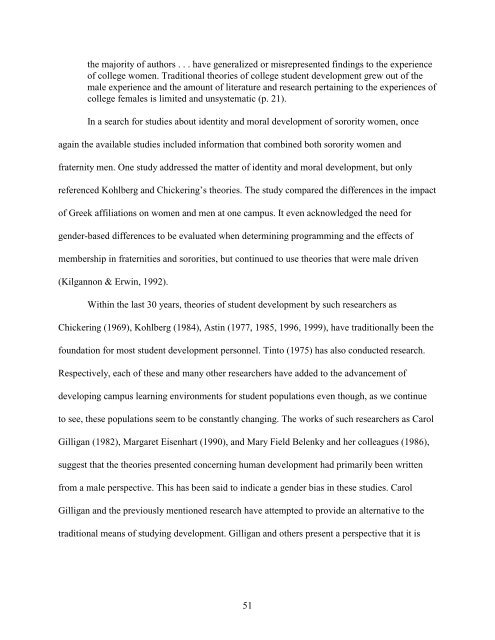Sorority Rituals - Reflections On Rites of ... - Mari Ann Callais
Sorority Rituals - Reflections On Rites of ... - Mari Ann Callais
Sorority Rituals - Reflections On Rites of ... - Mari Ann Callais
You also want an ePaper? Increase the reach of your titles
YUMPU automatically turns print PDFs into web optimized ePapers that Google loves.
the majority <strong>of</strong> authors . . . have generalized or misrepresented findings to the experience<br />
<strong>of</strong> college women. Traditional theories <strong>of</strong> college student development grew out <strong>of</strong> the<br />
male experience and the amount <strong>of</strong> literature and research pertaining to the experiences <strong>of</strong><br />
college females is limited and unsystematic (p. 21).<br />
In a search for studies about identity and moral development <strong>of</strong> sorority women, once<br />
again the available studies included information that combined both sorority women and<br />
fraternity men. <strong>On</strong>e study addressed the matter <strong>of</strong> identity and moral development, but only<br />
referenced Kohlberg and Chickering’s theories. The study compared the differences in the impact<br />
<strong>of</strong> Greek affiliations on women and men at one campus. It even acknowledged the need for<br />
gender-based differences to be evaluated when determining programming and the effects <strong>of</strong><br />
membership in fraternities and sororities, but continued to use theories that were male driven<br />
(Kilgannon & Erwin, 1992).<br />
Within the last 30 years, theories <strong>of</strong> student development by such researchers as<br />
Chickering (1969), Kohlberg (1984), Astin (1977, 1985, 1996, 1999), have traditionally been the<br />
foundation for most student development personnel. Tinto (1975) has also conducted research.<br />
Respectively, each <strong>of</strong> these and many other researchers have added to the advancement <strong>of</strong><br />
developing campus learning environments for student populations even though, as we continue<br />
to see, these populations seem to be constantly changing. The works <strong>of</strong> such researchers as Carol<br />
Gilligan (1982), Margaret Eisenhart (1990), and Mary Field Belenky and her colleagues (1986),<br />
suggest that the theories presented concerning human development had primarily been written<br />
from a male perspective. This has been said to indicate a gender bias in these studies. Carol<br />
Gilligan and the previously mentioned research have attempted to provide an alternative to the<br />
traditional means <strong>of</strong> studying development. Gilligan and others present a perspective that it is<br />
51



